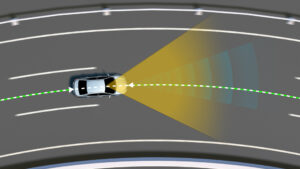
New Toyota research focuses on lane centering support, safe driving behavior
By onAnnouncements | Associations
Toyota says it is accelerating the development of vehicle safety features through three new research initiatives led by its Collaborative Safety Research Center (CSRC).
The initiatives are part of the OEM’s wider effort to help progress advanced driver assistance systems (ADAS).
One research topic, being conducted with the Massachusetts Institute of Technology Agelab, will establish metrics and evaluate the benefits of automated lane centering support.
“Researchers will analyze real-world data from volunteer drivers to understand the primary and secondary advantages of automated lane-keeping assistance,” Toyota said in a press release. “This research may provide valuable insights into how various driver support features help promote safe driving.”
Another set of research with the University of Michigan Transportation Research Institute (UMTRI) will work to develop prototype interventions to encourage safe driving behavior. Volunteer participants will again be used, this time to test the effectiveness of the suggested interventions.
Finally, CSRC will, in partnership with Touchstone Evaluations Inc., explore driver risk profiles.
“Researchers will use driving research data to quantify the relationships between personality, trip goals, and risky driving behaviors such as speeding, handheld device use, and tailgating,” Toyota said. “This research may help improve technology to aid driver decision-making and encourage safer behaviors.”
Toyota plans to share its research findings publicly.
“Our new research projects exemplify CSRC’s dedication to our mission of improving safety in the automotive industry,” said Danil Prokhorov, director of Toyota’s CSRC. “By collaborating with researchers to study real-world problems related to mobility technologies, we aim to develop enhanced engineering tools and empower drivers to maximize the potential of advanced technologies.”
Separately, Toyota joined the University of Michigan’s Vulnerable Road User Injury Prevention Alliance (VIPA) to support research into crashes with shared road users like pedestrians, cyclists, and those on electric scooters.
“VIPA seeks to enhance industry-wide understanding of common scenarios between motor vehicles and non-vehicle road users that have historically led to crashes and injuries, with an aim to ultimately contribute to the development of effective mitigation or prevention measures,” the OEM said.
That topic is being researched as the National Highway Traffic Safety Administration (NHTSA) moves to change its vehicle safety consumer information program to better educate consumers on how well vehicles guard pedestrians against injury.
The federal agency is seeking to amend its New Car Assessment Program (NCAP) to “provide valuable safety information to consumers about the ability of vehicles to protect pedestrians.”
It said doing so could incentivize automakers to produce vehicles built with safeguards that could prevent or minimize pedestrian injuries.
Toyota’s new projects are in addition to the 13 others it announced last year as part of its five-year, $30 million plan to advance initiatives related to vehicle safety.
Toyota’s CSRC was created in 2011 and has since received $115 million for safety research, including the development of ADAS-related testing procedures and tools.
Its current research phase is focused on three pillars. The first is to ensure that technologies are “universally accessible and comprehensible, enabling everyone to benefit from them.”
The others are meant to facilitate informed decision-making and safety strategies, and to mitigate risks associated with mobility technologies.
CSRC has previously participated in 98 research projects with more than 30 institutions and published more than 275 research papers.
Said Toyota: “The projects have made meaningful contributions to help advance research and technology relating to the safe integration of future mobility solutions for all.”
It has previously disclosed that it spends more than $1 million per hour globally on research and development to “ensure that the company remains a leader in mobility and vehicle technology that is safe, high-quality and appealing to both our customers and beyond.”
Images
Main image courtesy of Toyota
